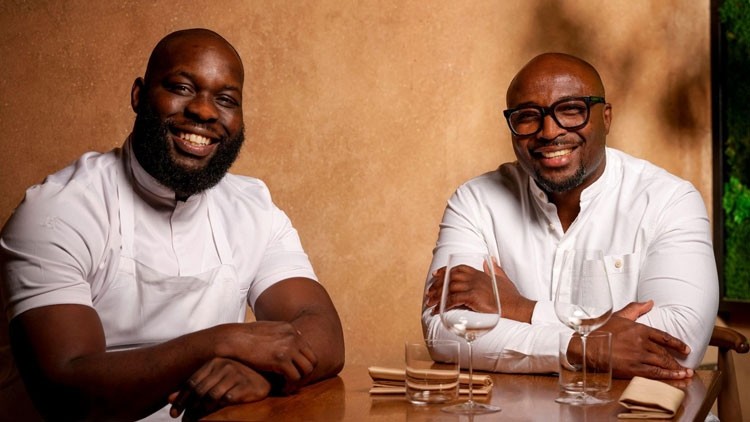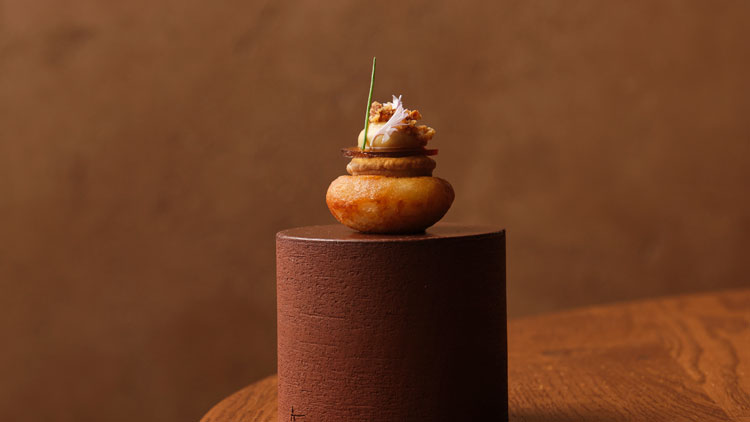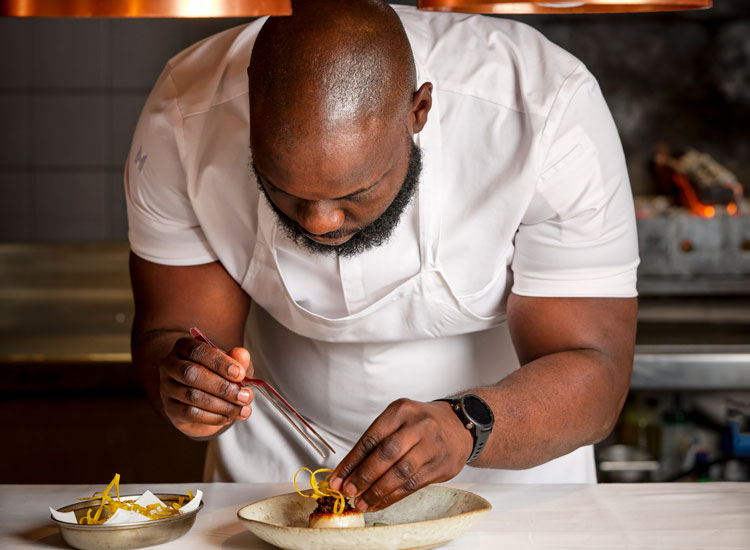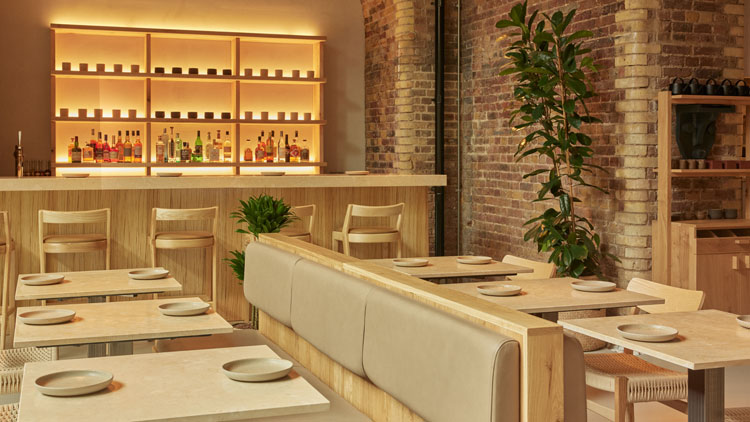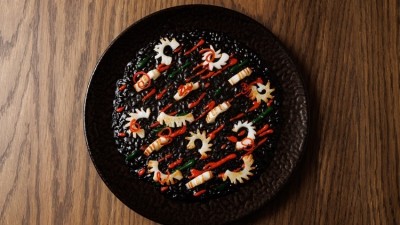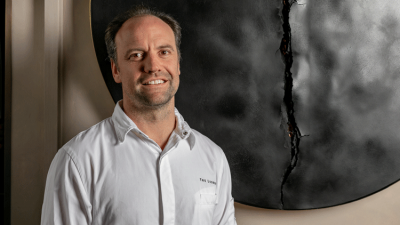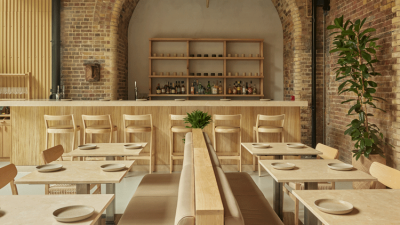Ayo Adeyemi: “Now that we’ve got Michelin’s recognition, I can be a bit braver”
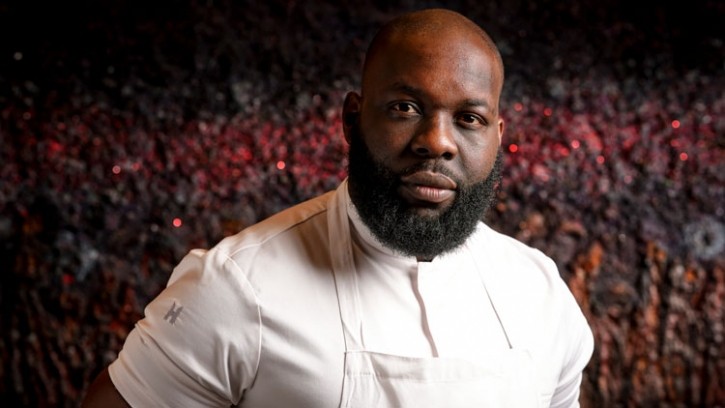
“The hard work starts now,” says Ayo Adeyemi, with a confident smile. The chef is reflecting on his recent success, which earlier this month culminated in him securing the first Michelin star for Akoko, the West African fine dining restaurant in London’s Fitzrovia of which he’s led the kitchen since October 2022.
It’s a significant accolade. Launched in October 2020 by restaurateur Aji Akokomi, Akoko is one of a handful of high-profile restaurants in the capital to bring greater attention to West African cuisine, which for too long has been under-represented and undervalued in gastronomic circles – another, Chishuru, was also awarded a Michelin star this year. With that in mind, no one could blame Adeyemi if he wanted to take a breath and bask in the achievement, but his focus is squarely back on the task at hand.
Indeed, he barely has time to stop and talk about his accomplishment. Our interview takes place at Akoko’s chef’s counter, which overlooks the restaurant’s kitchen. While I sit at the counter, Adeyemi stands for the duration of our chat, filleting mackerel with such impressively innate dexterity that he barely ever needs to look down at what he’s doing.
“All eyes are on us now, and we have to keep pushing
in order to ensure and justify that we deserve it”
“I’m very grateful,” he continues. “It’s a great award, both for me and the team, and it gives us something to boast about. But all eyes are on us now, and we have to keep pushing in order to ensure and justify that we deserve it.”
A learning curve
Adeyemi joined Akoko from Ryan Clift's Tippling Club in Singapore, becoming the restaurant’s third executive chef in just two years. Akokomi originally opened Akoko with chef William JM Chilila, a former MasterChef: The Professionals finalist, leading the kitchen. However, Chilila soon left the project to be replaced by Theo Clench, who himself subsequently departed the restaurant to launch Cycene with Blue Mountain School founders James and Christie Brown.
From the outside looking in, leading the kitchen at Akoko appeared to be something of a poisoned chalice, but Adeyemi, who was approached by Akokomi while still working at Tippling Club, saw it differently. “For me, it was one of those things that felt like a match made in heaven,” he says.
“I was at a point in my career where I was ready to take the next step, and Aji and I shared a natural synergy. We had a similar vision for the style of the food we’re doing, but also for how we thought the business could grow and evolve. And from the beginning, getting a Michelin star was part of that plan.”
Adeyemi was no stranger to cooking in Michelin-starred establishments. Prior to Tippling Club he worked at the Taj Campton Place Restaurant in San Francisco, which at the time held two Michelin stars. His CV also includes stints at Heston Blumenthal’s three Michelin-starred The Fat Duck and his one-star gastropub The Hind’s Head, both in Bray.
Cooking West African food in a professional setting, though, was more of a learning curve. Born in the UK to Nigerian parents, he grew up eating Nigerian food, with those flavours becoming second nature to him. “I hadn’t explored the cuisine of other West African countries and that’s where Aji’s partnership came in.”
“My job is to bring a sense of authenticity
to the menu and be creative about it”
As well as Nigeria, Akoko’s tasting menu, which runs for eight to 10 courses dependent on supplements, draws inspiration from the cuisines of Ghana, Gambia and Senegal. “Aji’s very well educated when it comes to those other cuisines, and we do a lot of research and development between us,” Adeyemi continues. “My job is to take what we learn and translate it into our style of cooking; making sure to bring a sense of authenticity to the menu and be creative about it.”
Fire, umami, and spice
The three cornerstones of Akoko’s culinary ethos are fire, umami, and spice. Nearly all of the dishes incorporate an element of live-fire cooking, courtesy of the custom wood fire grill that dominates the kitchen space. Plating, meanwhile, retains a minimalist style, intended to keep the focus on the punchy flavours of each dish.
Seasonality is also a fundamental. “The menu is designed to focus on the dish, not the protein, which allows us the always be flexible to what’s available,” explains Adeyemi. “That was actually the biggest adjustment for me [from Tippling Club]. Nothing comes from Singapore; everything is imported. One of the things I admire about UK restaurants is the strictness to which they adhere to seasonality.”
Naturally, much of the menu has changed since Adeyemi took the reins of the kitchen. New dishes include the waina (pictured), a fermented rice snack topped with chicken mousse and truffle; otoro, a tuna croustade with scotch bonnet kani; and asun, smoked goat with mustard seeds and burnt cucumber. The mackerel he’s preparing, meanwhile, will be used for the moimoi and served with vatapá.
Some dishes, however, have stayed, notably the two signatures: jollof rice, and suya. The rice, which has been on the menu since Akoko opened, is taken from Akokomi’s grandmother’s recipe. Served amid a billowing cloud of smoke, the dish is cooked in a stock of sweet pepper and umami and comes served, depending on the season, with the likes of either Herdwick lamb or native blue lobster on the top.
The suya, meanwhile, has evolved. Adeyemi made the decision early on to replace the lamb belly used in the dish with ox tongue. “It was a great opportunity to utilise a secondary cut,” says Adeyemi. “We serve it with a bone marrow emulsion, which is our take on a béarnaise sauce. It has this really nice acidity that cuts through the richness of the ox tongue, and the bone marrow is smoked. It’s a dish that demonstrates different applications of heat and smoke throughout the food.”
Being braver
Adeyemi likens the menu at Akoko to a ‘learning platform’ that’s designed to honour the culinary traditions of West African cuisine. “Our diners are very curious about the cuisine. They come from all over the world to visit us. Some are familiar with West African food, but many aren’t.”
He describes finding the right level of spice when developing dishes as the biggest challenge. “You’ve got to be smart. Some people are very sensitive to it, and so the way we apply it the menu as we transition through the dishes is done delicately.”
At the moment, he considers the menu to be ‘quite approachable’ to those who aren’t au fait with West African cuisine, but things are set to change. “Now that we’ve got the recognition from Michelin, I feel like I can be a bit braver. That’s going to come through on our new menu.”
Set to launch in the coming months, Akoko’s new menu will include a signature dish featuring tripe. “I really love cooking with offal and am always looking for more ways to feature it on the menu. However, a lot of people are afraid of it, so at the moment I often pair it with a primary cut. With the new menu, though, I’m looking to move away from that.
“I am becoming braver. I’m my own biggest critic and if I don’t think something works then I don’t sell it. But now I have the confidence and understanding of the restaurant and the London market to know what works.”
The more casual Akara
As well as Akoko, Adeyemi’s remit includes Akara, Akokomi’s newly-launched Borough Yards restaurant, which takes its name from a black-eye bean fritter that originated in West Africa. Pitched as a more casual counterpoint to Akoko, Akara champions the traditional flavours of West Africa in a relaxed setting that’s similarly monochromatic to its sister restaurant but retains its own look and feel.
Central to the menu, which Adeyemi and Akokomi developed together, is the eponymous fritters that come with fillings including barbecued tiger prawn; seared Orkney scallop; braised ox cheek; and wild mushroom. For mains, the restaurant serves a selection of barbecued meat, fish and vegetable plates that are mostly designed for sharing. Options include ex-dairy sirloin steak suya with charred roscoff onion and sweet pepper sauce; Lagos chicken with glazed carrot and Senegalese hot sauce; and grilled pollock with caramelised onion and lemon sauce.
“Akara was on the cards when I was offered the job at Akoko and was part of the reason I took it, to see the growth and evolution of the brand,” says Adeyemi. “It’s designed to be the sort of restaurant my family could eat and feel like they’re back at home.
“Sometimes you don’t need to reinvent the wheel and make something more fancy than it needs to be. Sometimes the key is to keep things natural and authentic. As long as it’s using good quality ingredients then people will appreciate it and that’s what we do across both of our restaurants.”
“Sometimes the key is to keep things natural and authentic”
Adeyemi usually only cooks at Akara for one service a week to ensure the kitchen is running smoothly, with his focus remaining on the development of Akoko. He won’t be drawn on whether he’s aiming for a second star in time, but it’s clear that his plan is to keep pushing. “I think what [Michelin] saw in us was a unique dining experience,” he says. “Something different and executed to a high level and standard.
“We’re fortunate that enough eyes have been on us. I wouldn’t call us trendsetters, but I believe we’re one of a kind and that’s one of the things that’s quite special about us.”
